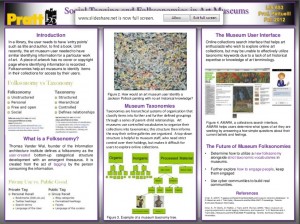In a library, the user needs to have ‘entry points’ such as title and author, to find a book. Until recently, the art museum user needed to have similar identifying information for a particular work of art. A piece of artwork has no cover or copyright page where identifying information is recorded. Folksonomies help art museums to identify items in their collections for access by their users.
Taxonomies are hierarchical systems of organization that classify items into further and further defined groupings through a series of parent-child relationships. Art museums use controlled vocabularies to organize their collections into taxonomies; this structure then informs the way their online galleries are organized. A top-down structure is helpful to museum staff, who need strict control over their holdings, but makes it difficult for users to explore online collections.
Folksonomies are user-created bottom-up categorical structure development with an emergent thesaurus. Folksonomies bridge the knowledge divide through the act of tagging by the people consuming the information. These can then be mapped to the curatorial vocabularies to create a richer discovery experience for museum website and database users.
LIS 653 Knowledge Organization final group project on Folksonomies and Social Tagging in Art Museums.
Please explore our poster and let us know what you think.

